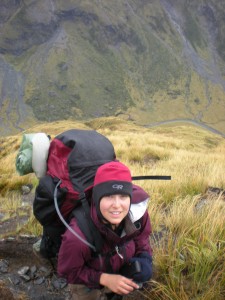(note: my blog font has turned into a nightmare. Sorry! I’ll fix it soon.)
Our seven-day trip into Mt. Aspiring National Park’s gem-country was epic, capped on either end by getting to spend time with Emily, Chris, and the kids! The trip featured endless river crossings, breathtaking valleys, looming-soaring-glacier-capped peaks, turquoise waters, plenty of scrambling, and a curious absence of wildlife. 1Wildlife in New Zealand barely registers on our U.S.-honed sense of wonder, unfortunately. There are no large native mammals. In fact… no native mammals at all, save for a bat. Birds are king here, and voracious hunting of introduced species (deer, opossums, rabbits) means that you see little more than cute little winged creatures in the woods. In a way, it’s nice not to worry about bears and the like. It feels like we’re in ancient, ancient forests where life is just finding its beginnings.
Day 1: trailhead to Young Bivy.
We got a late start, but the whole family saw us to the first river crossing — the mighty Makarora. We donned flip-flops and battled sandflies during the gear switch once across. It was ten minutes down the trail when we realized we’d left the golden nuggets of our food supply in the fridge at Chris and Emily’s. The chicken, the roast beef, the cream cheese, the pesto… for a few moments we were at our wits end with disappointment. Then we accepted our involuntary vegan fate, and walked on! We made it to the Young Bivy (a small two person shack accessible to us thanks to Chris and Emily) with a bit of autumn light left in the day, and we were thankful to skip setting up camp and move straight into dinner!
Day 2: Young Bivy to Young Basin
We climbed, dangled, and stretched across numerous spurs, ravines, and gulleys to reach the Young Hut (cabin) in time for lunch. As we neared the treeline a few hours later, ominous clouds started to flow down the mountainsides. We greeted the head of the Young Basin in all its alpine glory at 2 p.m. The next step is to climb Gillespie pass, but we weren’t sure we could make it up and down the other side before dark in inclement weather. Instead, we huddled against boulders cooking dinner and crawling into our sleeping bags well before the sun disappeared!
Day 3: Gillespie Pass to Siberia Valley
Having slept the entire night on top of my empty pack (for insulation from the cold ground — Jim Blanchard would be proud), we were more than eager to get going at first light. The trail to Gillespie Pass is straight up, gaining a foot in elevation with almost
every step! The views were so incredible and a reward in themselves. The descent took hours, and Siberia Valley found us smiling but exhausted. We tacked on another mile or so before finding a camp, making a few meals on the trail (literally), and calling it a night!
Day 4: Siberia to Top Forks via Kerin Forks and Jumboland
Lots of ice and a mysterious ground fog kept us company as we packed up and headed down the trail. For once, the walking mirrored the kind of hiking we are used to in the states, and we reached the Wilkin River in record time. We puttered around the banks to find the best crossing and finally settled on a place that was thigh deep. Our two person stability crossing (hold each other’s shoulders, take turns moving) had us on the other side and enjoying lunch and sunshine in a meadow before 11 a.m.! Then we scrambled for hours along the valley walls to Jumboland Flats (named for Jumbo the horse) where we beelined for Top Forks Hut several miles up the valley, crossing the Wilkin each time its meandering got in our way. The sunset glowing off the Mt. Pollux glacier welcomed us
to a warm hut where Brian, keeping watch on camp for his hunting buddies, offered us wine and myriad other treats they’d flown in by helicopter. SCORE!
Day 5: Top Forks to the Lakes
Our last day of new trail scenery was full of open alpine meadows, aquamarine waters, and snowy crags with a soundtrack of flowing creeks, calving glaciers (LOUD!), and chirping birds. We set off for Lake Diana, and chose Castilia at the fork in the trail — the very head of the Wilkin River! We scrambled over boulder fields and back and forth across creeks for two hours to finally slip into the bowl that contained the icy blue lake. We had a quick lunch and beat a hasty retreat against the incoming gloomy clouds. Back at the fork, we set off for Lake Lucidus and were
promptly awarded with our goal. The return to camp was relaxing, and Brian had us warm and wined in no time!
Day 6: Top Forks to Kerin Forks
This was our only day without new scenery, so it almost felt like a rest day. We took our time and lazed our way through all the ravines, gullies, down-climbing, etc. back to Kerin Forks. We had the hut to ourselves and Pat got the fire going so well we didn’t even need our sleeping bags!
Day 7: Kerin Forks to Makarora
We quickly learned why so many people either fly in to Kerin Forks or take the jet boat in and out. This stretch of the walk is, in a word, boring. The river flats fail to stun after days in remote Jumboland. Pat said he felt like his was back in Iraq with the helicopters flying overhead all day long. Avoiding cow-pies was a major focus of the day. All told, outside, walking with your best friend isn’t a too terrible a way to spend a day, and we were in no position to complain. The Makarora had risen after two evenings of rain, and so we struggled one last time against river current in soggy boots before arriving at the highway. I managed a ride in no time and returned with the van to deliver us to showers, pesto, and a cozy, dry evening!
More photos by clicking here.
References
| ↑1 | Wildlife in New Zealand barely registers on our U.S.-honed sense of wonder, unfortunately. There are no large native mammals. In fact… no native mammals at all, save for a bat. Birds are king here, and voracious hunting of introduced species (deer, opossums, rabbits) means that you see little more than cute little winged creatures in the woods. In a way, it’s nice not to worry about bears and the like. It feels like we’re in ancient, ancient forests where life is just finding its beginnings. |
|---|










1 ping